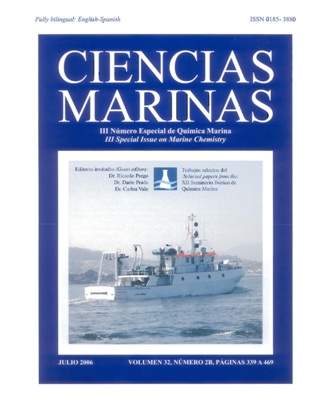Enzymatic activity of acid and alkaline phosphatase and catalase in Ruditapes philippinarum as biomarkers of stress caused by anionic (C11-LAS) and non-ionic (NPEO2.8) surfactants
Main Article Content
Abstract
A subchronic toxicity study was performed by exposing organisms to two surfactants in a continuous flow-through system for 120 h, followed by a depuration phase of 48 h. The bivalve mollusc Ruditapes philippinarum, widely distributed in intertidal zones and of high commercial value, was used. The main anionic and non-ionic surfactants employed were linear alkylbenzene sulphonate (LAS) and nonylphenol ethoxylate (NPEO2.8), respectively. The organisms were exposed to three environmental levels (µg L–1), and the concentrations of C11-LAS measured in the tissues were 2.4, 6.7 and 12.8 µg g–1 for the low, intermediate and high exposure levels, while those of NPEO2.8 were 13.4, 14.8 and 31.7 µg g–1, respectively. The responses used as "end point" of subcellular toxicity were the enzymatic activity of catalase (CAT), acid phosphatase (AcP) and alkaline phosphatase (ALP). No significant differences were observed in CAT activity at the end of the exposure phase; however, at the end of the depuration phase there was an increase in CAT activity in the organisms exposed to the low concentration of C11-LAS (P < 0.05) and a significant decrease in the individuals exposed to the high concentration of NPEO2.8, which is related to the largest accumulation of the compound inside the organism. The organisms exposed to the intermediate and high concentrations (P < 0.05) of C11-LAS showed inhibition for AcP and activation for ALP at the end of the experiment (day 7). In the organisms exposed to the high concentration of NPEO2.8 there was an increase in the specific activity at the end of the depuration stage.
Downloads
Article Details
This is an open access article distributed under a Creative Commons Attribution 4.0 License, which allows you to share and adapt the work, as long as you give appropriate credit to the original author(s) and the source, provide a link to the Creative Commons license, and indicate if changes were made. Figures, tables and other elements in the article are included in the article’s CC BY 4.0 license, unless otherwise indicated. The journal title is protected by copyrights and not subject to this license. Full license deed can be viewed here.

